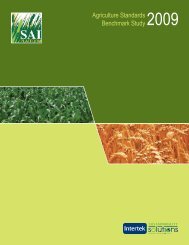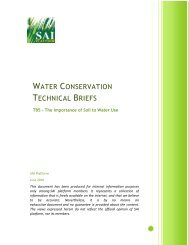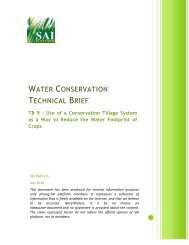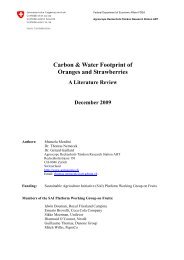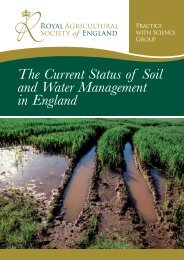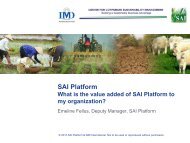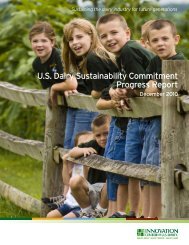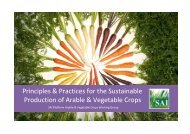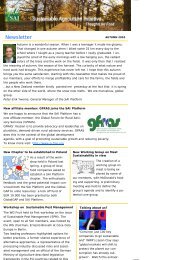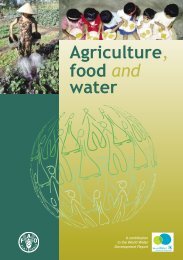DETAILED BENCHMARK ANALYSIS - SAI Platform
DETAILED BENCHMARK ANALYSIS - SAI Platform
DETAILED BENCHMARK ANALYSIS - SAI Platform
You also want an ePaper? Increase the reach of your titles
YUMPU automatically turns print PDFs into web optimized ePapers that Google loves.
WHOLE FARM SUSTAINABILITY<br />
<strong>DETAILED</strong> <strong>BENCHMARK</strong> <strong>ANALYSIS</strong><br />
GLOBAL G.A.P.<br />
www.globalgap.org<br />
Category: Whole Farm Sustainability<br />
Location coverage: Global<br />
Crop Coverage: Multiple Crops<br />
Type: Certification with label<br />
Contact Information:<br />
GLOBALGAP Secretariat<br />
c/o FoodPLUS GmbH<br />
Spichernstrasse 55<br />
50672 Cologne<br />
Germany<br />
I. CORE CRITERIA EVALUATION<br />
Criteria element is fully met with rigorous detail<br />
Criteria element is partially met and/or lacking in in-depth public information<br />
Criteria element is not met<br />
Criteria element is not applicable to the scheme<br />
A. GOVERNANCE & REGULATION OF THE SCHEME | Evaluate the rigorousness of how the scheme is run<br />
MULTI-STAKEHOLDER PROCESS | Scheme was developed via a transparent multi-stakeholder process which fully reflects the view of all interested<br />
stakeholders.<br />
• The standards development process is clearly outlined in the publically available “Procedures for the setting and revision of GLOBALGAP Standards,”<br />
which outlines the process for standard setting that include multiple stakeholders’ involvement. Global G.A.P. actively engages with many different stake<br />
holders around the globe, including retailers, local suppliers and technical experts to feed into the standard development. There is an interactive webpage<br />
for the public to directly comment on each standard.<br />
GOOD GOVERNANCE | Scheme is well maintained by a representative and transparent board<br />
• The standard is maintained by a Board and special committees representative of both retailers and suppliers. Information on Board and Committee<br />
Members is published online. The activities and responsibilities of the board are documented. The standard receives rigorous review and undergoes<br />
improvements on a 3 to 4 year cycle to ensure the most up-to-date market developments.<br />
CONFLICT OF INTEREST & DISPUTE RESOLUTION | There is a clear and transparent process by which conflicts of interests and disputes can be resolved<br />
• The General Regulations document describes the basic steps to ensure separation of activities which could cause a conflict of interest and ensure<br />
the integrity of the certifying body. And, it outlines complaint handling requirements for producer groups.<br />
ACCREDITATION (if applicable) | For certification schemes, the competency, authority and credibility of the Accreditation Body is reliable and meets the<br />
requirements of relevant ISO standards.<br />
• Certification is managed by a Certification Body Committee. Global G.A.P. signs service agreements with independent Certified Bodies (CBs) which act<br />
as independent auditing companies. There is well documented Certification Body Rules within the General Regulations that outlines the certification body<br />
approval process, ISO standards requirements, and inspector or auditor qualifications.<br />
LOGOS & CLAIMS (if applicable) | The Scheme has clear structure and rules for any claims made or the use of any logo<br />
• Rules for use of EurepGAP and Global Gap trademark and logos are outlined within the Standard Document under the section General Regulations. The<br />
logo is only permitted for use in a producers packhouse or warehouse. Global G.A.P. also operates a database of all certified producers worldwide where<br />
information about particular certified producers can be validated directly online.<br />
B. SYSTEMS ENHANCEMENT CRITERIA | Evaluate the inclusion of criteria elements within the scheme that go beyond the standard principles to enhance the<br />
performance of the farm<br />
MANAGEMENT SYSTEMS | The standard’s principles/criteria encourages or provides guidelines on the elements of an internal management system and its<br />
implementation, and discusses relevant policies and procedures involved.<br />
• Global G.A.P. criteria requirements for Producer Groups require the application of a quality management system across the whole group in order to ensure<br />
uniform compliance with the Global G.A.P. standard requirements within all production locations. It outlines management structure, document control<br />
and record keeping.<br />
CONTINUOUS IMPROVEMENT | The standard’s principles/criteria encourages or gives guidance to the user, through either internal audits or process<br />
benchmarking, in setting objectives and monitoring the results through which performance can be constantly improved over time.<br />
• Global G.A.P. has for criteria internal self-assessments and corrective actions. It lacks rigorous guidance and detail on monitoring and objective setting<br />
through which improvements can be tracked and improved over time.<br />
20 Agriculture Standards Benchmark Study | 2009



